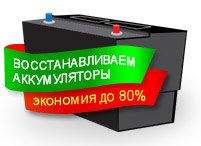The discharge of IKE supercapacitor manufactured by “Super Econd” company (electrochemical two-layer supercapacitor with carbon polarizable electrodes and alkaline electrolyte, operating voltage 400 V, maximum power 12 kW) was studied in two operating modes of the charge-discharge test bench:
- directly to constant resistive load (common discharge mode of the supercapacitor);
- discharge through a special device – an electronic separator (ES), which realized a special algorithm developed by “SWEL energy”. That algorithm provided the polarization component reduction of internal resistance in chemical cells.
The measurements were carried out by a digital two-channel oscillograph Tektronix TDS 1012B; the output load current was determined by a low-resistance shunt and a precise analogue millivoltmeter.
The real capacity of supercapacitor in the operational voltage range 390 – 200 V (the value used to calculate average discharge power) was defined beforehand during its charge. It turned out to be equal 0.69 F (0.72 F in voltage range 390 – 112 V) which was considerably lower than 0.8 F declared by the manufacturer.
Fig. 1 shows the supercapacitor discharge oscillogram at output voltage of electronic separator equaled 202 V, and constant output power equaled 4.07 kW (with due consideration of the test bench efficiency). Fig. 2 shows supercapacitor discharge directly to resistive load of 33.3 Ohm (35.6 Ohm, with due account to turn on/off loss).
After comparison of Fig. 1 and Fig. 2 it becomes evident that at comparable instantaneous load power (4.07 kW and 3.91 kW respectively) the level of initial voltage drop is much smaller with the electronic separator, than during capacitor discharge without separator (8 V and 20 V respectively). This denotes considerable polarization component reduction of internal resistance in supercapacitor during its discharge through electronic separator. Therefore, the efficiency of supercapacitor rises when it’s discharged through the separator in constant load power mode. This very effect is most evident during the rise of power and load current – the higher they are, the more evident is the difference of initial voltage dip on supercapacitor during its discharge through ES and without it. According to our estimations, under maximum load power for the given supercapacitor, the electronic separator can provide up to 40% of the gain.
We also carried out comparative tests on supercapacitor discharge in low power mode (~1150 – 1200 W) through electronic separator and without it. The measurements were taken according to the circuit (measuring circuit) with the only difference: the USB-multimeter was replaced by a digital two-channel oscillograph Tektronix TDS 1012B (in recorder mode). The stabilized voltage on the output equaled 111 V, the constant power delivered to load – 1147 W, period of time when constant output power was maintained during discharge, was 39.2 seconds.
| U initial of capacitor., V | U stab.heat., V | R heat., Ohm | I stab., А | t stab., sec. | W, kW | E, kJ | E (efficiency coef.), kJ |
| 390.0 | 111.0 | 10.75 | 10.33 | 39.20 | 1.147 | 44.95 | 49.4 |
During supercapacitor discharge directly to load (chosen in a way that to provide about the same average discharge power, as with ES connected) the average power based upon back calculation, comprised 1.158 kW, the energy extracted from supercapacitor during its discharge down to 112 V voltage equaled 45 kJ.
| U init. of cap., V | U final of cod., V | R heat., Ohm | t discharge, sec. | W, kW | E, kJ |
| 390.0 | 112.0 | 33 | 38.8 | 1.158 | 45.0 |
Thus, the energy extracted from supercapacitor during its common discharge, turned out to be the same as the energy transferred to load during discharge through the ES. Meanwhile, in the given environment the test bench efficiency doesn’t exceed 90 – 91%. In other words, the supercapacitor transfers 10% more energy during discharge through ES. As mentioned above, with extracted power rise the ES efficiency increases and can achieve 40% and more in the limit.
Comparison of the supercapacitor discharge through the electronic separator and without
 |
 |



